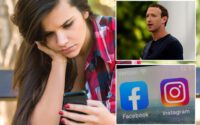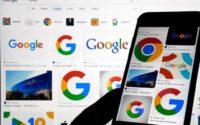I’m a brand expert, here’s why Google, Facebook, and Twitter have blue logos
Have you ever wondered why certain colors are synonymous with specific brand logos and why we instantly recognize the bluebird?
No? Hmm…
Well, maybe you’ve noticed that some of the most recognizable logos in the world are all blue.
Think Facebook, LinkedIn, Skype, and Telegram… to name a few.
*Nods slowly as you realize just how many damn logos are in fact, blue*

Well, turns out it’s all to do with ~psychology~. OOooOooOooO
New research by print company Solopress has revealed the best-performing colors for business logos within the food, drink, fashion, finance, and tech industries as well as the psychology behind how color can impact our purchasing decisions.
Black and blue dominate 53% of logos in the tech industry
The first interesting tidbit to come out of the study is that black and blue logos dominate the tech industry, accounting for 53% of the total best-performing brand logos in the world.
Blue, in particular, is often used for social media apps and is used by 30% of the best-performing tech companies.

But why’s that, you ask? Surely they’d want to differentiate themselves, right?
Neuromarketing expert, Katie Hart explains, “Interestingly, the color blue is now often associated with communication too, which may derive from these feelings of security and safety.”
She then goes on to say that tiny changes to the exact shade of blue can make all the difference too.
“In fact, Google changed the specific shade of blue they use for their links when a search comes up to a more ‘reddish’ blue. Did you notice it had changed? No? Well, they attribute that change alone as contributing an additional $200m of advertising revenue per year. Per year! And most people didn’t even consciously notice that it had changed,” she says.

Ironically, the color blue also calms us down, reduces our impulsive tendencies, and lowers our heart rate (all things I personally don’t associate with social media apps, but hey everyone’s different!)
Red and pink dominate food and drink
On the flip side, red and pink are the favorite colors of the food and drink industries, accounting for 41% of the food industry and 29% of the drink industry.
Hart comments, “Longer wavelength colors, like red, are known to have a stimulating effect on recipients. They arouse us and drive us into action. At some levels, red colors increase our appetite, heart rate, and even blood pressure, making us act faster, be more impulsive and potentially eat more.”
Can you see now why this is such a popular color to use in the food and drink industries, particularly fast food chains?


Nom, nom, nom…
Neuromarketing and color psychology affects the way we think and behave
As you can see, all this behind-the-scenes neuromarketing and color psychology really does have a significant impact on the way we behave, communicate, think, feel, and consume.
Ultimately, it also affects our purchasing habits too.
And perhaps the scariest part is, color affects us subconsciously, according to Hart, meaning we’re not truly aware of the power it has over us. We have no control over it whatsoever.
Food for thought…


